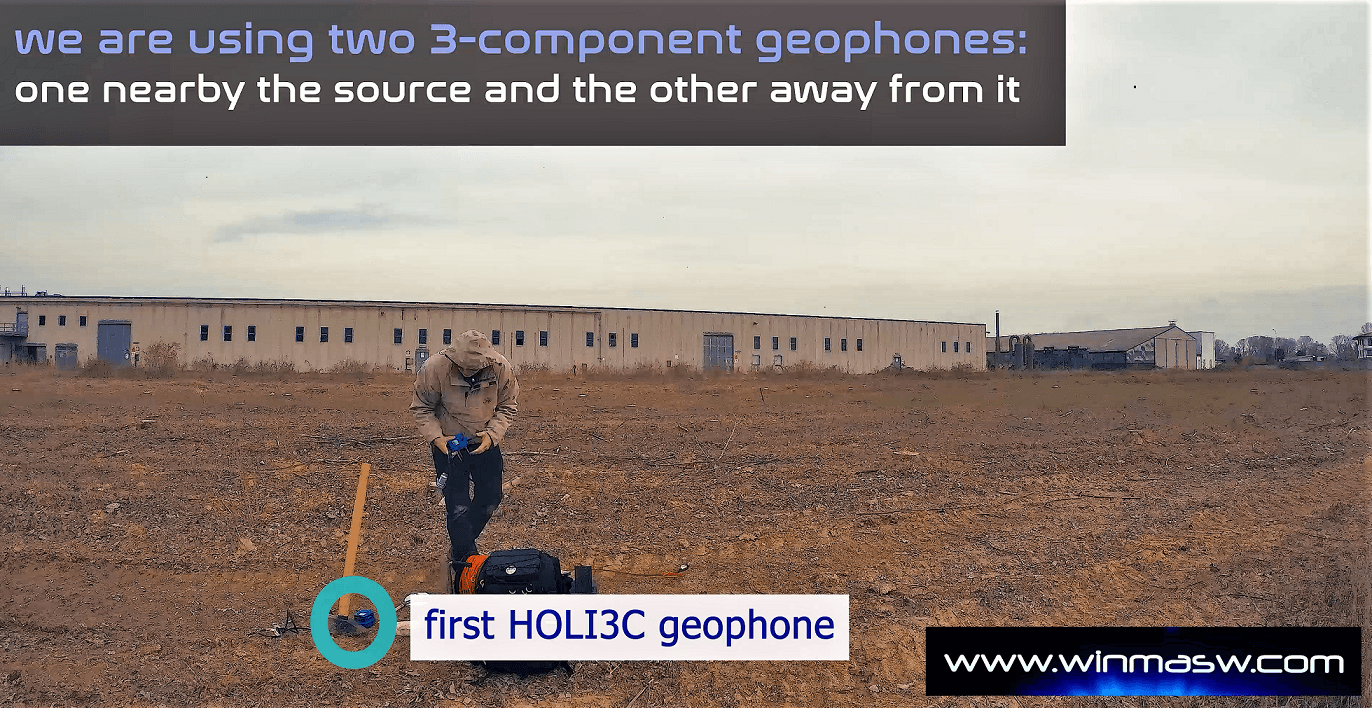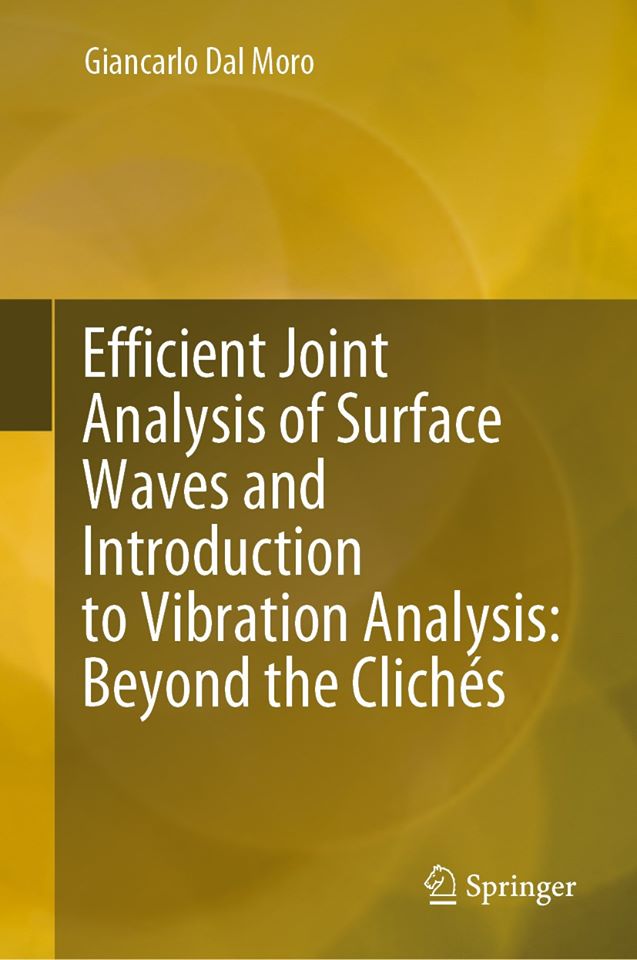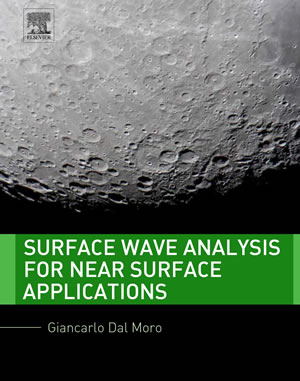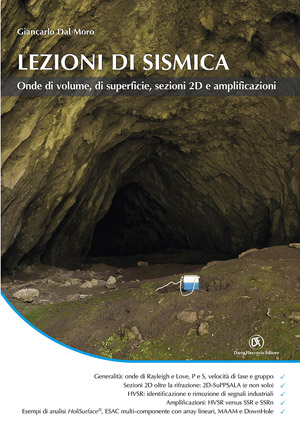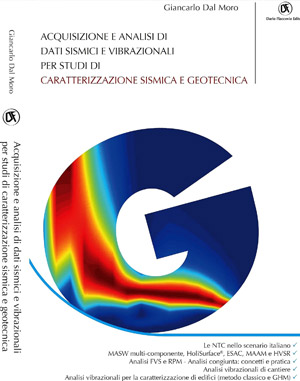HoliSurface®
"Less is more"
Ludwig Mies Van Der Rohe
What is HoliSurface®?
HoliSurface® is a new software application for seismic exploration via joint analysis of active and passive data obtained through acquisition procedures extremely simple and efficient fundamentally based on the smart exploitation of all the data that can be obtained through a mindful use of a single 3-component geophone (and little more).
The software HoliSurface® employs an innovative methodology - patent granted on 01.04.2015 - and has been created to fully exploit everything you can do with just one 3-component geophone: Rayleigh and Love waves Group velocities analysis (radial and vertical component) according to FVS (Full Velocity Spectrum) approach, HVSR analysis, MAAM (Miniature Array Analysis of Microtremors) analysis, Vs profile reconstruction, vibration measurements.
The word HoliSurface® (briefly HS) is composed by Holistic and Surface and means that the purpose of the method/software is to analyze the propagation of surface waves in a complete way, namely holistic (from Greek ὅλος, "totality").
Acquiring a dataset useful for HoliSurface® analysis is not much different than traditional acquisitions of active seismic aimed, for example, at performing MASW or refraction analysis (the zero time is set by the trigger). The substantial difference is that, to perform HoliSurface® analysis, you have to use only a single 3-component geophone (3C - also said 3D because it is a geophone with three sensors oriented in three spatial orthogonal directions) whose orientation is fundamental. The key point is that the second trace of the output file must represent the radial component (namely the direction that is the axis combining/joining the source and the geophone). To correctly perform HoliSurface® analysis will be, therefore, necessary to set the NS of the 3-component geophone radial respect to the source.
Video introduction to the standard data acquisition according to our patented HoliSurface® methodology
A further possible (estremely efficient) way to record the active and passive data at once: HERE THE VIDEO
What kind of analyses can I do with HoliSurface®?
The software HoliSurface® allows to perform different types of analysis according to both active and passive seismic methodologies:
- MFA (Multi Filter Analysis) and HoliSurface® analysis according to Full Velocity Spectrum approach (active seismic): multi-component active seismic by using a single 3C geophone
- Joint analysis of dispersion and HVSR (Horizontal-to-Vertical-Spectral Ratio)
- HVSR (Horizontal to Vertical Spectral Ratio) analysis
- MAAM (Miniature Array Analysis of Microtremors): micro-array passive seismic
- RPM (Rayleigh-wave Particle Motion) curve analysis
- Building Vibrational Analyses coupled, uncoupled and GHM (Gaussian-filtered Horizontal Motion) method
- Vibrations analysis according to UNI 9614 and DIN 4150
- Site Response (Response Spectra) computation
Click HERE for some introductory videos about some of the HS features
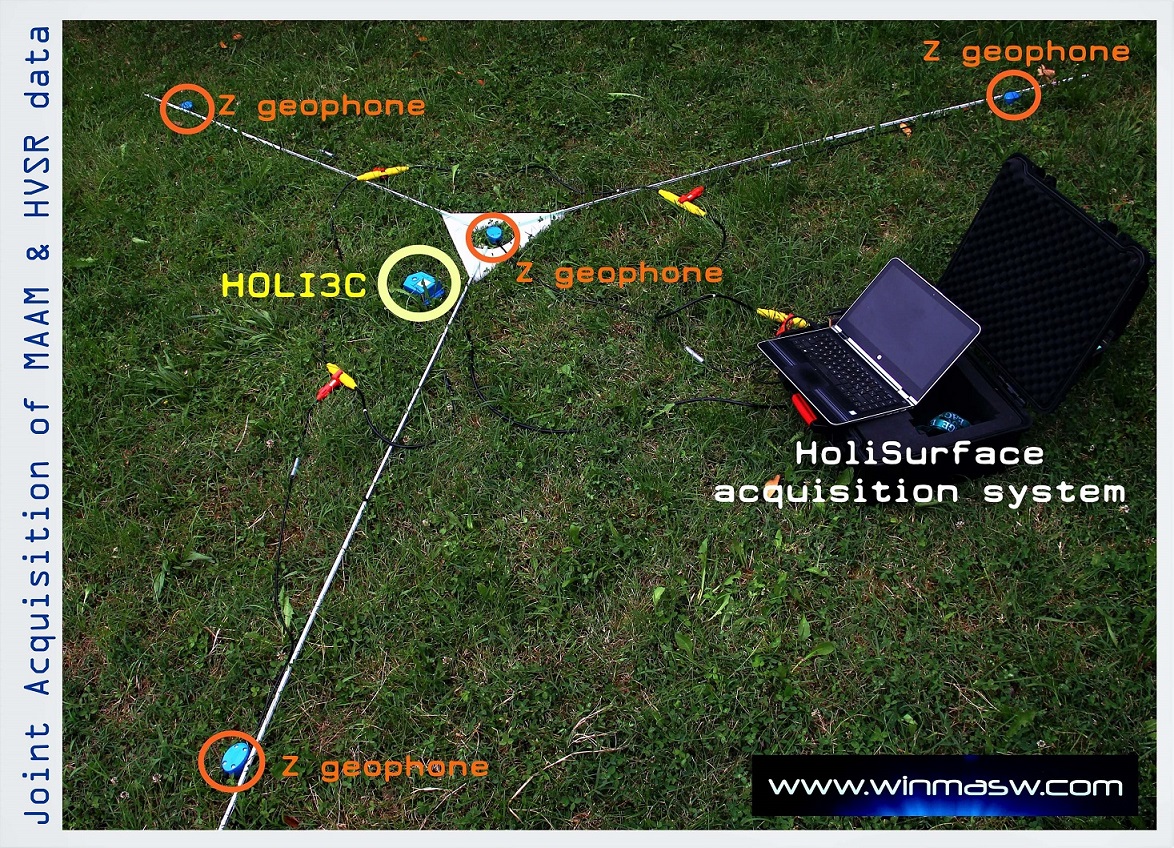
AREA51 device for MAAM acquisitions together with the four tested vertical geophones for the MAAM and the HOLI3C geophone for the HVSR (as well as for the HS)
Where are published the methods implemented in HoliSurface®?
- Eigenmode identification and characterization via GF3DPM analysis
Dal Moro G., Proceedings of the EAGE (European Association of Geoscientists & Engineers) Near Surface Geoscience 2024 Conference (Helsinki, Finland, 8-12 September 2024) - Determination of the Vs profile at a "noisy" industrial site via active and passive data: the critical role of Love waves and the opportunities of multi-component group velocity analysis
Dal Moro G. and Mazanec M., 2024, GEOPHYSICS, 0: 1-77. https://doi.org/10.1190/geo2022-0540.1 - Multiple-peak HVSR curves: Management and statistical assessment
Dal Moro G., Panza G.F., 2021, Engineering Geology, https://doi.org/10.1016/j.enggeo.2021.106500 - Efficient Joint Analysis of Surface Waves and Introduction to Vibration Analysis: Beyond the Clichés
G. Dal Moro, 2020, Springer, ISBN 978-3-030-46303-8 - Acquisizione e analisi di dati sismici e vibrazionali per studi di caratterizzazione sismica e geotecnica
G. Dal Moro, 2019, Dario Flaccovio Editore, ISBN 9788857908786 - Mapping bedrock topography of the Lower Aare valley using seismic surface waves
Keller L., Dal Moro G., Spillmann T., Deplazes G., Madritsch H., 7th Swiss Geoscience Meeting, Fribourg 2019 (22-23 November 2019) - On the efficient acquisition and holistic analysis of Rayleigh waves: Technical aspects and two comparative case studies
Dal Moro G., Al-Arifi N., Moustafa S.R., 2019, Soil Dynamics and Earthquake Engineering 125 (2019) 105742, https://doi.org/10.1016/j.soildyn.2019.105742 - Effective Active and Passive Seismics for the Characterization of Urban and Remote Areas: Four Channels for Seven Objective Functions
Dal Moro G., 2018, Pure and Applied Geophysics, 2018, https://doi.org/10.1007/s00024-018-2043-2
Available for online reading at the following link: https://rdcu.be/bbT04 - Influenza della modellazione degli edifici sulla determinazione della loro vulnerabilità sismica
Sancin L., Dal Moro G., Amadio C., Romanelli F., Vaccari F., 2018, Extended abstract for the GNGTS 2018 assembly (gngts.ogs.trieste.it), Lavoro vincitore del premio AGCL 2018 - Gaussian-filtered Horizontal Motion (GHM) plots of non-synchronous ambient microtremors for the identification of flexural and torsional modes of a building
Dal Moro G., Weber T., Keller L., 2018, Soil Dynamics and Earthquake Engineering, 112, 243–255 - Improved Holistic Analysis of Rayleigh Waves for Single- and Multi-Offset Data: Joint Inversion of Rayleigh-Wave Particle Motion and Vertical- and Radial-Component Velocity Spectra
Dal Moro G., Moustafa S.R., Al-Arifi N., 2017, Pure and Applied Geophysics, DOI 10.1007/s00024-017-1694-8 - Single- and Multi-Component Inversion of Rayleigh Waves Acquired by a Single 3-Component Geophone: an Illustrative Case Study
Dal Moro G., Puzzilli L. M., 2017, Acta Geodyn. Geomater., Vol. 14, No. 4 (188), 431–444, DOI: 10.13168/AGG.2017.0024 - RPM Analysis and Advanced Joint Processing of a SED (Swiss Seismological Service) Dataset
Dal Moro G., Keller L., 2017, Proceedings of the GNGTS congress (14-16 November 2017 - Trieste, Italy), 693-696 - Analysis of Rayleigh-Wave Particle Motion from Active Seismics
Dal Moro G., Al-Arifi N., Moustafa S.R., 2017, Bulletin of the Seismological Society of America (BSSA), 107, 51-62 - Shear-wave velocity profiling according to three alternative approaches: a comparative case study (Dal Moro G., Moustafa S.R., Keller L., Al-Arifi N., Moustafa S.R., 2016), Journal of Applied Geophysics, 134, 112–124
- Four Geophones for seven possible objective functions: active and passive seismics for tricky areas
Dal Moro G., Invited presentation and Extended Abstract for the Urban Geophysics workshop of the 22nd EAGE Near Surface Geoscience conference (4-8 September 2016 - Barcelona, Spain) - Less is more: from van der Rohe to the 4-channel system for the efficient and holistic acquisition and analysis of surface waves. An urban case study.
Dal Moro G., Moustafa S.R., Al-Arifi N., 2015. Proceedings of the GNGTS (Gruppo Nazionale Geofisica della Terra Solida - ogs.trieste.it) congress (17-19 November 2015 - Trieste, Italy) - Geophysikalische In-situ-Bestimmung der Eingangsparameter in die seismischen Standortanalysen am Beispiel des Ambassador House Opfikon
Keller L., Weber T., Dal Moro G., 2015. Proceedings of the 14th D-A-CH conference of the Swiss Society for Earthquake Engineering and Structural Dynamics, Zurich, August 21-21, SIA D0255, ISBN 978-3-03732-060-0 - A Comprehensive Seismic Characterization via Multi-Component Analysis of Active and Passive Data
Dal Moro G., Keller L., Poggi V., 2015, First Break, 33, 45-53 - Efficient acquisition and holistic analysis of Rayleigh waves
Dal Moro G., Moustafa S.R., Al-Arifi N., Proceedings of the Near-Surface EAGE 2015 congress (Turin - Italy) [having received a very high score from the reviewers, the work was invited to be published in Near Surface Geophysics] - Joint Inversion of Rayleigh-Wave Dispersion and HVSR of Lunar Seismic Data from the Apollo 14 and 16 sites
Dal Moro G., 2015, ICARUS, 254, 338-349 - Unconventional Optimized Surface Wave Acquisition and Analysis: Comparative Tests in a Perilagoon Area
Dal Moro G., Ponta R., Mauro R., 2015), Appl. Geophysics, 114, 158-167 - Surface Wave Analysis for Near Surface Applications
Dal Moro G., 2014), Elsevier, ISBN 978-0-12-800770-9, 252pp (theory, field practice and advanced joint analysis) [see in particular paragraphs 2.2, 7.2 and case studies #2, 6, 8, 12 and 14]
For new papers please regularly visit our publication area
For further details, please take a closer look at the HoliSurface® manual available HERE
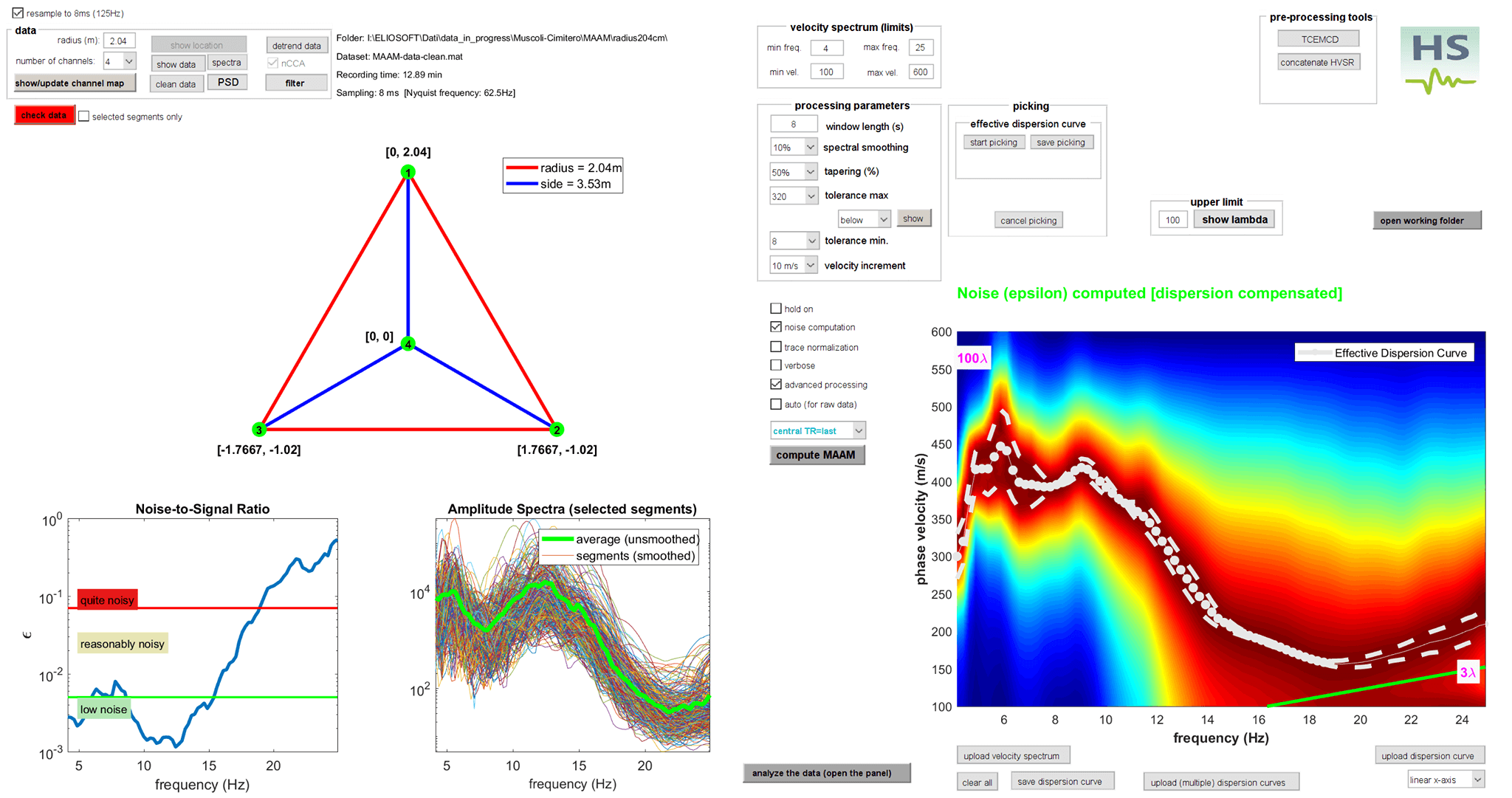
HoliSurface® from the Alps to the Moon...
Thanks to its simple acquisition procedures and the several utilities to efficiently manage the data and properly present them (handling GPS data, trace selection and filtering, vertical stack and much more), HoliSurface® has been used for the analysis of seismic data of various geological contexts: from the characterization of some sites in the Swiss Alps made for NAGRA "Nationale Genossenschaft für die Lagerung radioaktiver Abfälle" (National Cooperative for the Disposal of Radioactive Waste - Switzerland) to the analysis of seismic data collected by NASA during the Apollo Missions on the Moon (Dal Moro, EAGE Near Surface 2013, see publications).
The above photos show the Mars Rover Curiosity (courtesy of Mattel), the vehicle used for the exploration of the Red Planet.The same way as the Rover efficiently explores very remote and extreme environments, the active and passive methodologies implemented in HoliSurface® require very light and easy-to-carry equipment and limited space, but can nevertheless provide very robust subsurface models.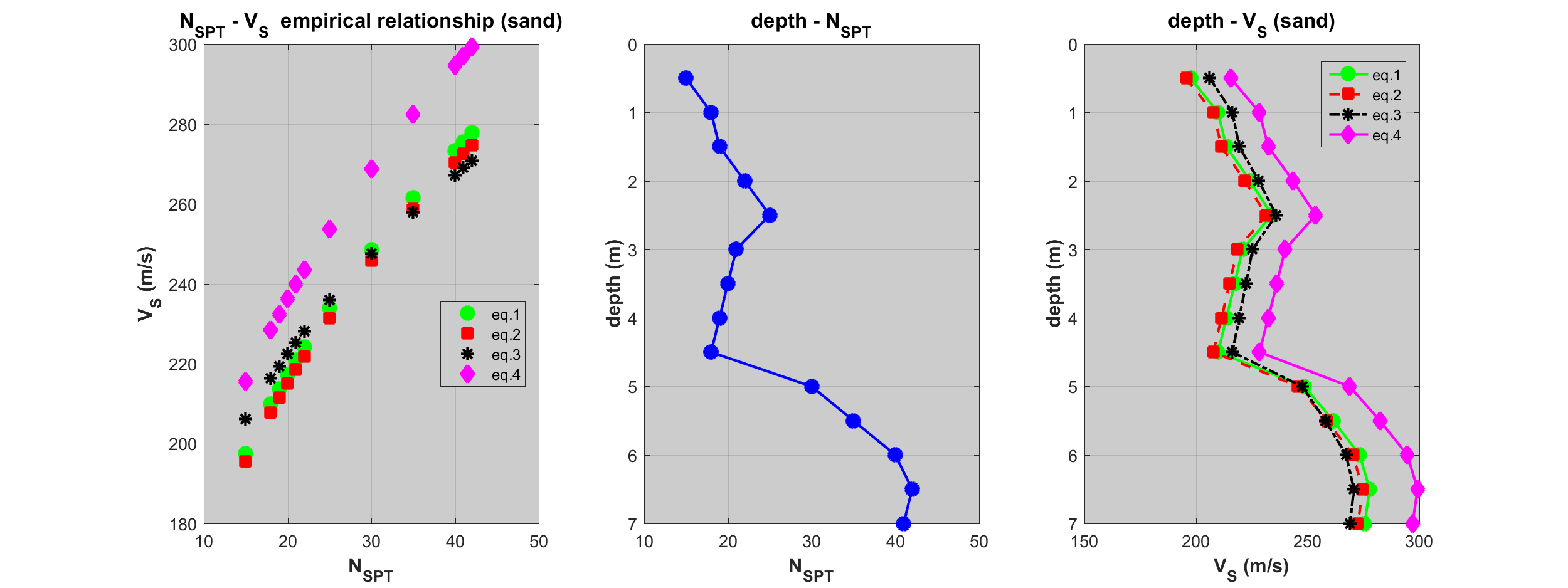
Nspt-Vs conversion
be smart, be Holi!
Manuale HoliSurface® [IT]
HoliSurface® manual [EN]


